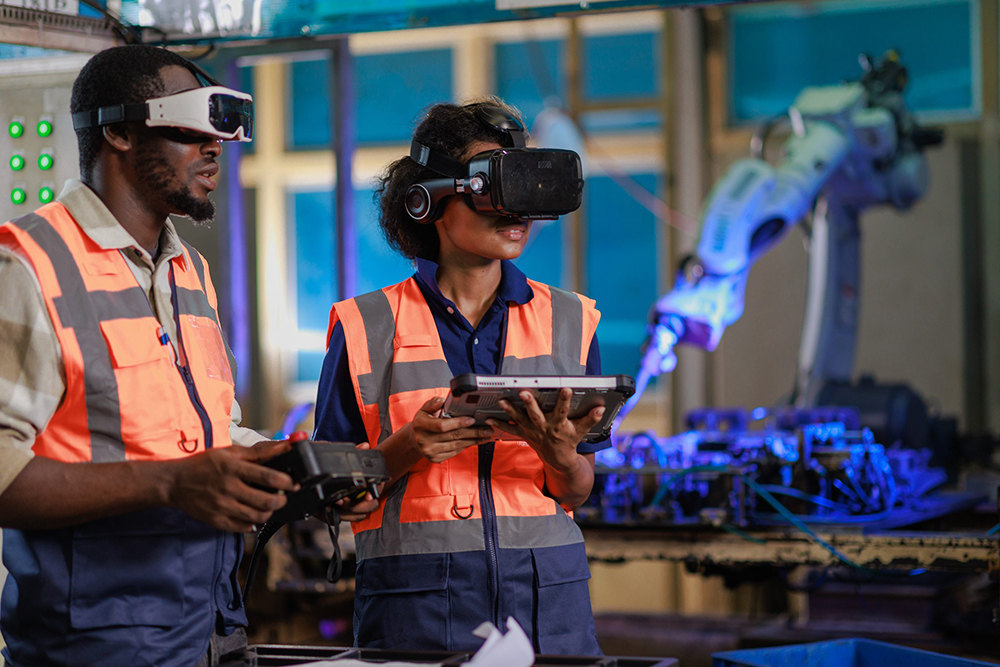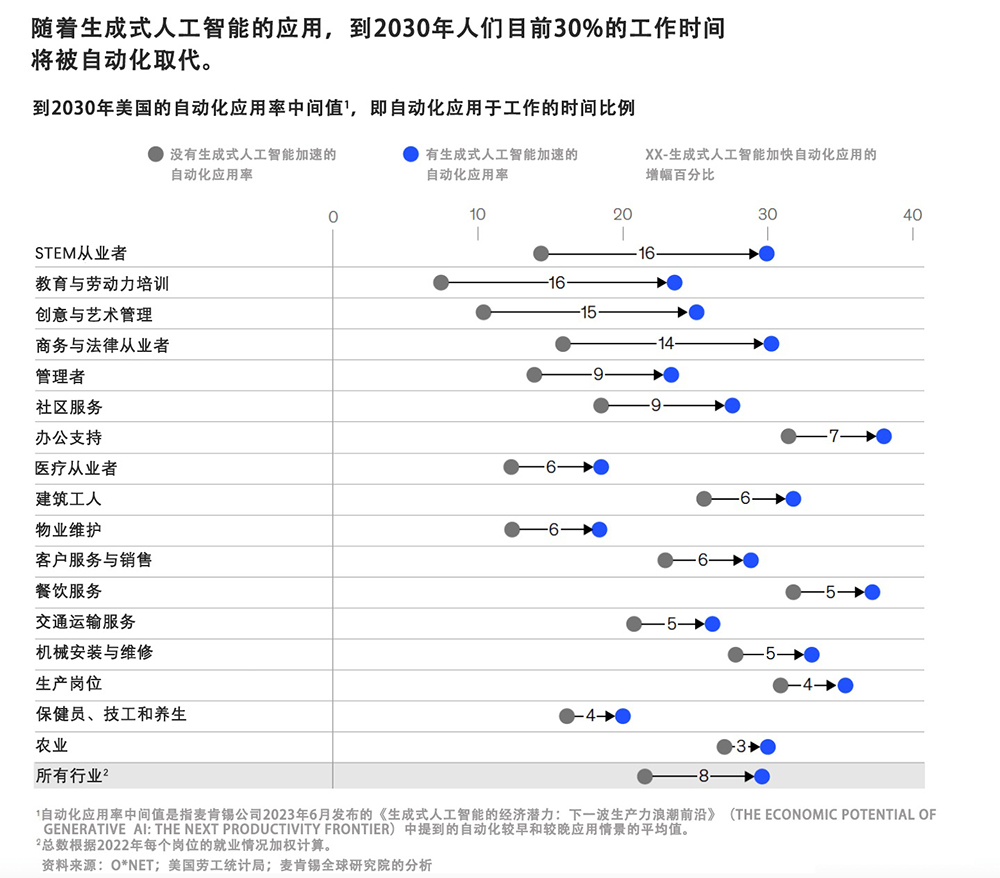麦肯锡报告称,生成式人工智能迫使美国1,200万人更换职业

关于人工智能对劳动力的影响,人们分成了两个阵营,有人警告人工智能会导致大规模失业,但有人却幻想着未来的乌托邦,任何人都可以自由追求自己的梦想,不需要辛苦从事一份职业。关于生成式人工智能具体将如何转变劳动力,目前还没有定论,但专家和上班族们都认为改变不可避免。
咨询业巨头麦肯锡(McKinsey)新发布的一份综合报告希望通过评估各类工作岗位未来的变化,对这些即将到来的变化进行量化。重要的是,麦肯锡的研究得出了一个到目前为止不太常见的观点,那就是从长远来看人工智能不会消灭人类的工作。尽管这项研究“至少在短期内无法明确排除就业损失的可能性”。受到生成式人工智能影响最大的行业可能到2030年依旧会增加就业岗位,只是就业增长速度低于之前的预期。
相反,人工智能会改变完成某些工作的方式,或者为低薪岗位的员工创造通过接受充分培训从事高薪岗位的机会。麦肯锡的报告估计,到2030年将有1,200万人更换职业,比其两年前的预测增加了25%。上班族会因为各种原因更换职业。有些人可能看到他们的工作岗位消失,但也有人会从事更高薪酬的岗位,或者对他们的技能需求更高的领域。
例如,麦肯锡认为,医疗护理行业截至4月已经有约190万个职位空缺,到2030年将新增约550万个就业岗位。随着科技行业以外的公司持续将人工智能整合到日常运营当中,对STEM(科学、技术、工程和数学)工作的需求也将增长23%。生成式人工智能执行行政管理任务方面的相关能力,意味着到2030年对办公支持和客户服务等岗位的需求将分别减少18%和13%。同期内对餐饮服务岗位的需求预计也会下降,只是下降幅度只有2%。办公支持岗位的需求减少对女性的影响尤其明显,而客户服务和餐饮服务岗位的需求减少尤其会影响到黑人和拉丁裔员工。
因此,现在的挑战并不是减慢这种下降的趋势,而是保证上班族为新岗位得到恰当的培训。麦肯锡建议从高中开始尽早接受STEM领域的培训。麦肯锡还建议公司扩大招聘范围,将失业者和没有接受过高等教育的人群包含在内,以避免未来招聘时遭遇挑战。
对于目前尚未失业的人们而言,他们的工作性质将会发生显著改变,因为他们30%的工作时间将由生成式人工智能自动完成。报告称:“重要的是,自动化应用与工作岗位被淘汰是两回事。许多工作岗位的任务可以在一定程度上改为自动化,这些岗位会保留下来,但人们日常工作的性质和工作方式会发生改变。”

麦肯锡估计,如果没有生成式人工智能,现有技术将把美国员工约22%的工作时间自动化。而这个比例之所以能够提高到30%,可以归功于ChatGPT、Bard、DALL-E和其他工具,因为它们能执行需要专业知识的任务,甚至能够完成以前的技术无法完成的创意工作。这将使生成式人工智能成为第一项淘汰知识工作和低薪岗位的技术。例如,律师不需要再审核合同法,因为自然语言模型可以代替他们完成。[法律人工智能初创公司Casetest在6月以6.5亿美元的价格被汤森路透(Thomson Reuters)收购。]平面设计师通常拥有美术学位,至少还有一定的天赋,但他们可能发现Midjourney和DALL-E可以减少完成一份插画需要的草稿数量。
麦肯锡预计会有1,200万人更换职业,这为毕业生们找到高薪岗位创造了机会。麦肯锡的分析估计,将有110万个薪酬不超过38,200美元的岗位消失,但年薪68,700美元的岗位会增加380万个。这并不意味着薪酬最低的岗位不会受到严重影响。在美国工资水平位于后40%的上班族,即收入不超过38,200美元的群体,需要换工作的概率是高收入者的14倍。虽然这份报告冷冰冰地承认,美国一些最低收入岗位不会受到影响,因为公司支付的超低工资,低于安装人工智能系统完成这些工作的成本,但一项统计数据却证明人工智能可能扩大现有的收入不平等。(财富中文网)
翻译:刘进龙
审校:汪皓
关于人工智能对劳动力的影响,人们分成了两个阵营,有人警告人工智能会导致大规模失业,但有人却幻想着未来的乌托邦,任何人都可以自由追求自己的梦想,不需要辛苦从事一份职业。关于生成式人工智能具体将如何转变劳动力,目前还没有定论,但专家和上班族们都认为改变不可避免。
咨询业巨头麦肯锡(McKinsey)新发布的一份综合报告希望通过评估各类工作岗位未来的变化,对这些即将到来的变化进行量化。重要的是,麦肯锡的研究得出了一个到目前为止不太常见的观点,那就是从长远来看人工智能不会消灭人类的工作。尽管这项研究“至少在短期内无法明确排除就业损失的可能性”。受到生成式人工智能影响最大的行业可能到2030年依旧会增加就业岗位,只是就业增长速度低于之前的预期。
相反,人工智能会改变完成某些工作的方式,或者为低薪岗位的员工创造通过接受充分培训从事高薪岗位的机会。麦肯锡的报告估计,到2030年将有1,200万人更换职业,比其两年前的预测增加了25%。上班族会因为各种原因更换职业。有些人可能看到他们的工作岗位消失,但也有人会从事更高薪酬的岗位,或者对他们的技能需求更高的领域。
例如,麦肯锡认为,医疗护理行业截至4月已经有约190万个职位空缺,到2030年将新增约550万个就业岗位。随着科技行业以外的公司持续将人工智能整合到日常运营当中,对STEM(科学、技术、工程和数学)工作的需求也将增长23%。生成式人工智能执行行政管理任务方面的相关能力,意味着到2030年对办公支持和客户服务等岗位的需求将分别减少18%和13%。同期内对餐饮服务岗位的需求预计也会下降,只是下降幅度只有2%。办公支持岗位的需求减少对女性的影响尤其明显,而客户服务和餐饮服务岗位的需求减少尤其会影响到黑人和拉丁裔员工。
因此,现在的挑战并不是减慢这种下降的趋势,而是保证上班族为新岗位得到恰当的培训。麦肯锡建议从高中开始尽早接受STEM领域的培训。麦肯锡还建议公司扩大招聘范围,将失业者和没有接受过高等教育的人群包含在内,以避免未来招聘时遭遇挑战。
对于目前尚未失业的人们而言,他们的工作性质将会发生显著改变,因为他们30%的工作时间将由生成式人工智能自动完成。报告称:“重要的是,自动化应用与工作岗位被淘汰是两回事。许多工作岗位的任务可以在一定程度上改为自动化,这些岗位会保留下来,但人们日常工作的性质和工作方式会发生改变。”
麦肯锡估计,如果没有生成式人工智能,现有技术将把美国员工约22%的工作时间自动化。而这个比例之所以能够提高到30%,可以归功于ChatGPT、Bard、DALL-E和其他工具,因为它们能执行需要专业知识的任务,甚至能够完成以前的技术无法完成的创意工作。这将使生成式人工智能成为第一项淘汰知识工作和低薪岗位的技术。例如,律师不需要再审核合同法,因为自然语言模型可以代替他们完成。[法律人工智能初创公司Casetest在6月以6.5亿美元的价格被汤森路透(Thomson Reuters)收购。]平面设计师通常拥有美术学位,至少还有一定的天赋,但他们可能发现Midjourney和DALL-E可以减少完成一份插画需要的草稿数量。
麦肯锡预计会有1,200万人更换职业,这为毕业生们找到高薪岗位创造了机会。麦肯锡的分析估计,将有110万个薪酬不超过38,200美元的岗位消失,但年薪68,700美元的岗位会增加380万个。这并不意味着薪酬最低的岗位不会受到严重影响。在美国工资水平位于后40%的上班族,即收入不超过38,200美元的群体,需要换工作的概率是高收入者的14倍。虽然这份报告冷冰冰地承认,美国一些最低收入岗位不会受到影响,因为公司支付的超低工资,低于安装人工智能系统完成这些工作的成本,但一项统计数据却证明人工智能可能扩大现有的收入不平等。(财富中文网)
翻译:刘进龙
审校:汪皓
Discussions of A.I. in the workforce oscillate between alarm bells of mass unemployment and fantasies of a future utopia where everyone is free to pursue their passions instead of grinding out a career. While the particulars of how generative A.I. will transform the workforce may be debatable, experts and workers alike believe that change is inevitable.
A comprehensive new report from consulting giant McKinsey tries to quantify these impending changes by examining how the mix of jobs might change over time. Crucially, McKinsey’s research reaches a point of view that has been uncommon so far in the discourse—that A.I. will not wipe out jobs in the long term. Even though the research in question “cannot definitively rule out job losses, at least in the short term.” The sectors most exposed to generative A.I. could still add jobs through 2030 but at a slower pace than previously anticipated, the report concludes.
Instead, A.I. will either change the way certain jobs are done or create an opportunity for employees in lower-paying jobs to move into high-paying positions, provided they receive adequate training. McKinsey’s report estimates 12 million people will switch careers by 2030, 25% more than it projected just two years ago. Workers will change careers owing to a variety of factors. Though some may see their jobs disappear, others will gravitate toward higher paying fields, or ones where their skills are in greater demand.
For example, health care, which, according to McKinsey, already has an estimated 1.9 million job openings as of April, will add roughly 5.5 million new jobs through 2030. There will also be a 23% increase in demand for STEM jobs, as companies outside the tech industry continue to integrate A.I. into their day-to-day operations. Generative A.I.’s relative competency at performing administrative tasks means demand for jobs like office support and customer service will decline 18% and 13%, respectively, through 2030. Food service can also expect a decline in demand, although at a much lower level of 2% over the same time frame. The reduced job demand in office support roles will disproportionately affect women, while reduced demand in customer service and food service poses outsize risks to Black and Hispanic employees.
The challenge, then, is not so much mitigating these declines as it is ensuring that workers are properly trained for new roles. McKinsey advises starting training as early as high school for STEM fields. It also advises companies to head off eventual hiring challenges by expanding their applicant pools to include unemployed people and those without higher education.
For those who remain in their current jobs, the nature of their work will change dramatically as 30% of their work hours will be automated away by generative A.I. “It is important to note that automation adoption is not the same as eliminating jobs,” the report says. “Many jobs with some automatable tasks will remain, but the day-to-day nature of what people do and how they do it changes.”
McKinsey estimates that without generative A.I. current technologies could automate roughly 22% of work hours among U.S. employees. The increase to 30% can be attributed to ChatGPT, Bard, DALL-E, and other tools’ ability to perform tasks that require genuine expertise, even creativity that previous technologies couldn’t achieve. This would make generative A.I. one of the first technologies to eliminate knowledge work as well as lower paying jobs. For example, lawyers will no longer have to review contract laws, because natural language models could do it for them. (The legal A.I. startup Casetext sold to Thomson Reuters for $650 million in June.) Or graphic designers, who usually have a fine arts degree in addition to at least some natural talent, might find that Midjourney and DALL-E can reduce the number of drafts needed for an illustration.
McKinsey’s anticipated 12 million worker reshuffle presents opportunities for some to graduate into higher paying jobs. McKinsey’s analysis calculates losses of 1.1 million jobs paying $38,200 or less, with a 3.8 million increase in those offering salaries of $68,700 a year. That’s not to say the lowest paid workers won’t be heavily affected. People in the bottom 40% of wage brackets in the U.S., those who earn $38,200 or less, are up to 14 times as likely to need to change jobs. Although the paper makes a chilling admission that some of the lowest paying jobs in the country may be unaffected because it’s cheaper for companies to pay extremely low wages than it is to install an A.I. system to do those jobs—a statistic that gives credence to concerns A.I. would widen existing income inequality.













